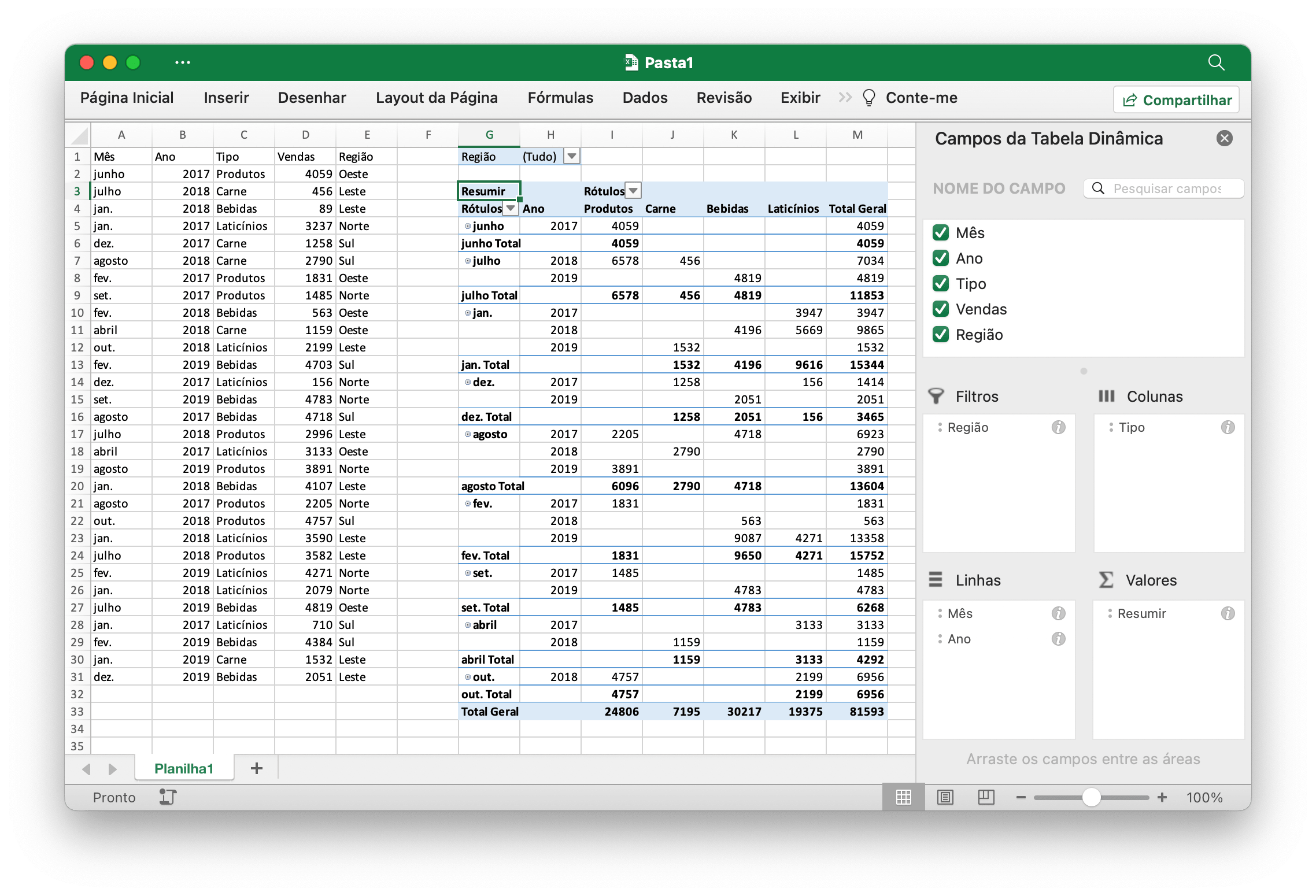Tabela dinâmica
Uma tabela dinâmica é uma tabela de estatísticas que resume os dados de uma tabela mais extensa (como de um banco de dados, planilha ou programa de business intelligence). Este resumo pode incluir somas, médias ou outras estatísticas, que a tabela dinâmica agrupa de maneira significativa.
PivotTableOptions mapeia diretamente as configurações de formato da tabela dinâmica.
type PivotTableOptions struct {
DataRange string
PivotTableRange string
Name string
Rows []PivotTableField
Columns []PivotTableField
Data []PivotTableField
Filter []PivotTableField
RowGrandTotals bool
ColGrandTotals bool
ShowDrill bool
UseAutoFormatting bool
PageOverThenDown bool
MergeItem bool
ClassicLayout bool
CompactData bool
ShowError bool
ShowRowHeaders bool
ShowColHeaders bool
ShowRowStripes bool
ShowColStripes bool
ShowLastColumn bool
FieldPrintTitles bool
ItemPrintTitles bool
PivotTableStyleName string
// contém campos filtrados ou não exportados
}
PivotTableStyleName: Os nomes de estilo de tabela dinâmica integrados:
PivotStyleLight1 - PivotStyleLight28
PivotStyleMedium1 - PivotStyleMedium28
PivotStyleDark1 - PivotStyleDark28
PivotTable Field mapeia diretamente as configurações de campo da tabela dinâmica.
type PivotTableField struct {
Compact bool
Data string
Name string
Outline bool
ShowAll bool
InsertBlankRow bool
Subtotal string
DefaultSubtotal bool
NumFmt int
}
Subtotal especifica a função de agregação que se aplica a este campo de dados. O valor padrão é Soma. Os valores possíveis para este atributo são:
| Valor Opcional |
|---|
| Average |
| Count |
| CountNums |
| Max |
| Min |
| Product |
| StdDev |
| StdDevp |
| Sum |
| Var |
| Varp |
Name especifica o nome do campo de dados. São permitidos no máximo 255 caracteres no nome do campo de dados; os caracteres em excesso serão truncados.
Criar tabela dinâmica
func (f *File) AddPivotTable(opts *PivotTableOptions) error
AddPivotTable fornece o método para adicionar tabela dinâmica por meio de determinadas opções de tabela dinâmica.
Por exemplo, crie uma tabela dinâmica na área Planilha1!$G$2:$M$34 com a região Planilha1!$A$1:$E$31 como fonte de dados, resumindo por soma para vendas:

package main
import (
"fmt"
"math/rand"
"github.com/xuri/excelize/v2"
)
func main() {
f := excelize.NewFile()
defer func() {
if err := f.Close(); err != nil {
fmt.Println(err)
}
}()
if err := f.SetSheetName("Sheet1", "Planilha1"); err != nil {
fmt.Println(err)
return
}
// Crie alguns dados em uma planilha
month := []string{"jan.", "fev.", "março", "abril", "maio",
"junho", "julho", "agosto", "set.", "out.", "nov.", "dez."}
year := []int{2017, 2018, 2019}
types := []string{"Carne", "Laticínios", "Bebidas", "Produtos"}
region := []string{"Leste", "Oeste", "Norte", "Sul"}
f.SetSheetRow("Planilha1", "A1", &[]string{"Mês", "Ano", "Tipo", "Vendas", "Região"})
for row := 2; row < 32; row++ {
f.SetCellValue("Planilha1", fmt.Sprintf("A%d", row), month[rand.Intn(12)])
f.SetCellValue("Planilha1", fmt.Sprintf("B%d", row), year[rand.Intn(3)])
f.SetCellValue("Planilha1", fmt.Sprintf("C%d", row), types[rand.Intn(4)])
f.SetCellValue("Planilha1", fmt.Sprintf("D%d", row), rand.Intn(5000))
f.SetCellValue("Planilha1", fmt.Sprintf("E%d", row), region[rand.Intn(4)])
}
if err := f.AddPivotTable(&excelize.PivotTableOptions{
DataRange: "Planilha1!A1:E31",
PivotTableRange: "Planilha1!G2:M34",
Rows: []excelize.PivotTableField{
{Data: "Mês", DefaultSubtotal: true}, {Data: "Ano"}},
Filter: []excelize.PivotTableField{
{Data: "Região"}},
Columns: []excelize.PivotTableField{
{Data: "Tipo", DefaultSubtotal: true}},
Data: []excelize.PivotTableField{
{Data: "Vendas", Name: "Resumir", Subtotal: "Sum"}},
RowGrandTotals: true,
ColGrandTotals: true,
ShowDrill: true,
ShowRowHeaders: true,
ShowColHeaders: true,
ShowLastColumn: true,
}); err != nil {
fmt.Println(err)
return
}
if err := f.SaveAs("Pasta1.xlsx"); err != nil {
fmt.Println(err)
}
}
Obtenha tabelas dinâmicas
func (f *File) GetPivotTables(sheet string) ([]PivotTableOptions, error)
GetPivotTables retorna todas as definições de tabela dinâmica em uma planilha por determinado nome de planilha.
Excluir tabela dinâmica
func (f *File) DeletePivotTable(sheet, name string) error
Excluir tabela dinâmica exclui uma tabela dinâmica fornecendo o nome da planilha e o nome da tabela dinâmica. Observe que esta função não limpa os valores das células no intervalo da tabela dinâmica.